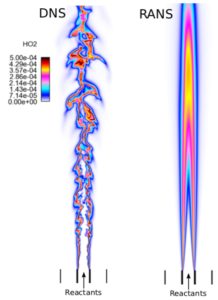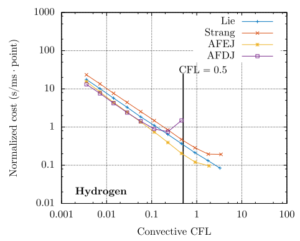Turbulent Combustion Modeling
Many current turbulence models for Large–Eddy Simulation (LES) and Reynolds-Averaged Navier–Stokes (RANS) simulations restrict the direction of energy transfer from the unresolved scales (or fluctuating fields) to the resolved scales (or mean fields). These constraints are overly restrictive for certain turbulent combustion regimes, in which energy transfer away from the small scales may have significant effects on the large-scale turbulence. Using high-fidelity Direct Numerical Simulation (DNS) data and physics-constrained statistical approaches, we investigate the energy dynamics in regimes in which correctly modeling flame–turbulence interactions is crucial to the predictive success of LES and RANS. These predictive capabilities may be essential to the design of next-generation premixed combustors for low-emission jet engines and high-efficiency stationary gas turbines.
Plasma-coupled Combustion
Flame ignition and stabilization are critical operational concerns in the design of supersonic-combusting ramjet engines (scramjets) for high-speed flight. One possible route involves flame ignition by focused-laser-induced optical breakdown, in which charged-species kinetics and post-shock hydrodynamics evolve simultaneously. The combination of these phenomena has been observed to give rise to flame instabilities, including the well-known cellular instability, but the precise transition mechanism from micro-scale evolution to macro-scale instability is unknown. We explore these mechanisms using highly detailed one-, two-, and three-dimensional numerical simulations that include plasma kinetics, multi-component diffusion, and low-dissipation shock-capturing methods. Possible future directions include the use of adaptive-grid and wavelet-based discretizations and investigation of the transition mechanism from combustion instability to turbulent combustion.
Numerical Methods for Turbulence

Numerical simulations of turbulent flows grow increasingly complicated and computationally expensive as their degree of realism increases, for example, by increasing chemical-kinetic fidelity, turbulent Reynolds number, Damköhler number, geometric complexity, and/or multiphysical coupling (e.g., MHD equations). As the first exascale (1018 floating-point operations per second) supercomputers are built, and as this computational power is derived from increasingly heterogeneous architectures, resilient algorithms will be required that dynamically minimize the risk of serious bottlenecks. We aim to develop flexible and efficient computational paradigms to ensure continued productivity of our large-scale fluid dynamics simulations on current world-class compute architectures and on machines to come. In low-Mach-number turbulent flows, which often utilize implicit or semi-implicit algorithms, the development of localized projection methods using accelerators is particularly important in reducing the communication costs typically associated with these algorithms.
Deep Learning for Fluid Dynamics

It is no secret that the Age of Data has resulted in the availability of a wealth of tools for high-dimensional data fitting and decision-making, many of which are optimized for high-performance, heterogeneous compute architectures and which are being rapidly assimilated into the world of science. Machine learning methods have proven wildly successful in areas such as image recognition (or is it really all cat recognition?), but much work remains in their application to physics-constrained problems in engineering and applied science. Using physics-constrained training methods, including an adjoint-equation-based a posteriori training algorithm for LES, we apply tools such as the PyTorch library to turbulence model development for canonical turbulent flows. So far, we have used these methods to produce models of comparable accuracy to “traditional” turbulence models on coarser computational grids, which translates to significantly reduced computational cost. Alternatively, for fixed computational cost, the deep learning-based approach can produce models of much higher accuracy. Extensions to more complicated flows, including turbulent reacting flows, are underway.